Decorative antique mirrors are a statement piece for modern interiors, reminiscent of the baroque and rococo periods and historic grandeur. From the swirling ribbons of Chippendale designs to the natural curves of Art Nouveau, gilded frames can be highly valuable and much sought after depending on their provenance and visual appeal.
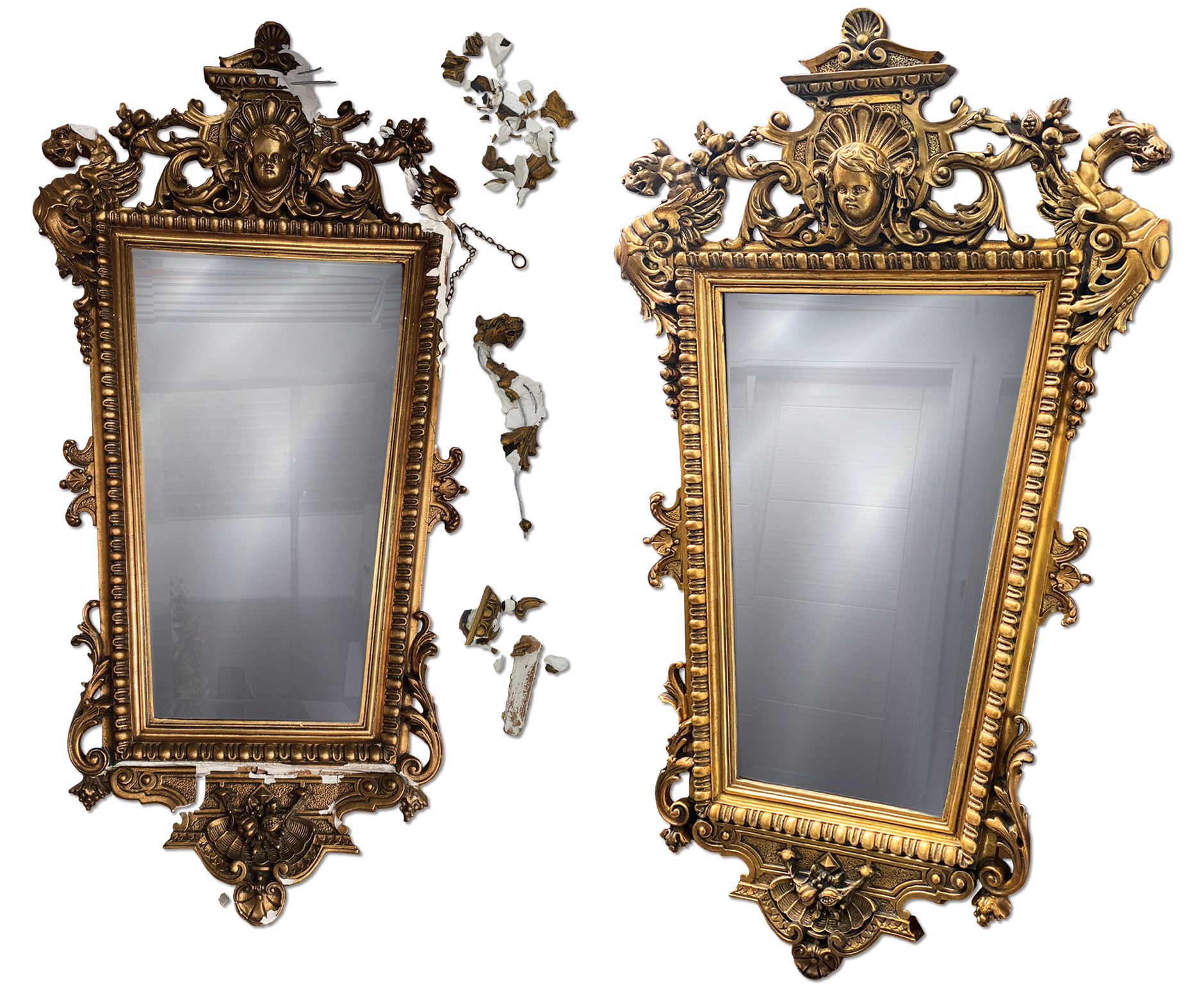
The historic nature of antique mirror frames makes them vulnerable to age-related damage, as well as loss of their sensitive gilding that may continue to perish as time goes on. Caring for typical giltwood decorative frames with knowledgeable routine maintenance will help to preserve surfaces and prevent the acceleration of preventable atmospheric deterioration.
 Above: typical styles of antique mirrors with gold leaf used in different shades on a variety of decorative details
Above: typical styles of antique mirrors with gold leaf used in different shades on a variety of decorative details
This article will cover the history of these charming antique wall pieces, as well as the expert ways in which they can be cared for at home. We will also discover the possibilities of professional mirror frame restoration and how your gilded frame can be expertly revived with the skill of our frame and gilding conservation team. 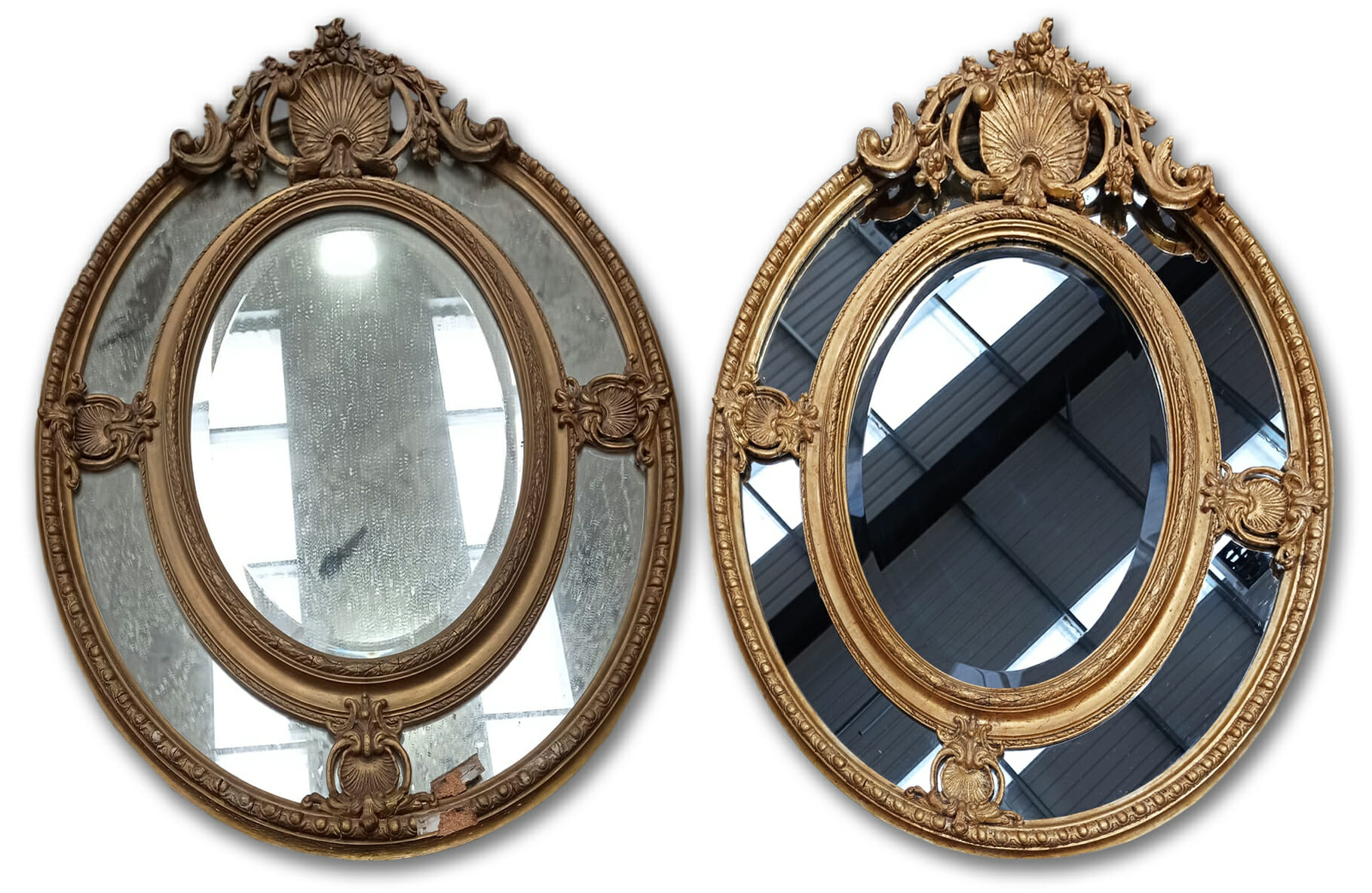
The history & value of antique wall mirrors
Like many forms of art, decorative mirrors can be dated back to the renaissance period. During the 16th century, the most fashionable designs were from Italy, most precisely from Murano on the coast of Venice – an epicentre of glass manufacturing that thrived with the patronage of wealthy merchants and Mediterranean trade. Early renaissance mirrors used a tin-mercury amalgam to achieve their reflective quality, this was adhered by fire-gilding one side on a flat piece of glass. This early manufacturing process was also popular in Nürnberg, Germany.
 Above: mirrors in art were also popular during the renaissance period, you will often find depictions of Venus looking into a mirror – this detail is from a Paolo Veronese painting dated to 1555
Above: mirrors in art were also popular during the renaissance period, you will often find depictions of Venus looking into a mirror – this detail is from a Paolo Veronese painting dated to 1555
The guild for mirror makers began in 1569, marking the height of this early trade in decorative yet functional designs. However, the classic appearance of Murano mirrors does not include a gilded wooden frame, they instead featured details and scenes engraved into the glass or colour and gilding painted directly onto the mirror. The prices for Venetian mirrors were high due to their secret formula for manufacturing success, but this was soon discovered and spread across the rest of Europe.
 Above: 17th century and early 18th century mirrors with gilt decorative frames made from wood and gesso
Above: 17th century and early 18th century mirrors with gilt decorative frames made from wood and gesso
The 17th century saw a rise in British mirror design, early mirrors not only feature the giltwood finish we associate with them today but an array of materials including ivory, ebony, tortoiseshell, silver or wooden marquetry featuring walnut and laburnum. Carved designs throughout this period are in keeping with fashionable furniture, such as the Dutch influence of William and Mary and later Queen Anne styles. Mirrors were in many cases bespoke for an interior space, such as above a mantelpiece. Past auction results for Queen Anne mirror sconces have reached over £500,000 for a set of four.
 Above: late 17th century and early 18th century mirrors with gold leaf on gesso, enamel with precious stones, venetian glass and inlaid wood
Above: late 17th century and early 18th century mirrors with gold leaf on gesso, enamel with precious stones, venetian glass and inlaid wood
The 17th century also saw the awe-inspiring creation of Versailles under the rule of the Sun King Louis XIV and the famous hall of mirrors. Constructed between 1678 and 1684, the hall featured 17 large mirrors opposite 17 windows facing out to the gardens of the palace. The mirrors are composed of 350 individual pieces to achieve a size that was phenomenal for its time.
 Above: examples of 18th century mirror frame styles including baroque, rococo and neoclassical styles
Above: examples of 18th century mirror frame styles including baroque, rococo and neoclassical styles
Interiors during the 18th century began to be dictated by the furniture guides produced by British designers Thomas Chippendale and Thomas Sheraton. Chippendale designed a variety of mirrors as well as other furniture pieces for the home, these typically included fashionable details such as opulent rococo florals, birds, ribbons, and neoclassical features. You can find out more about Chippendale furniture here.
 Above: designs by Thomas Chippendale for a Chinoiserie frame and a mirror inspired by the designs of Thomas Chippendale, William Ince and John Mayhew, 1760s
Above: designs by Thomas Chippendale for a Chinoiserie frame and a mirror inspired by the designs of Thomas Chippendale, William Ince and John Mayhew, 1760s
Large mirrors produced in Britain are rare in the 18th century, these were usually constructed instead by putting various smaller mirrors together in a frame to provide the same effect at a lowered cost, this also allowed owners to recycle their mirrors when new frames and interior fashions changed.
 Above: large mirrors had to be constructed from several pieces to achieve their size, you may find that two mirrors have been recycled to form one large piece
Above: large mirrors had to be constructed from several pieces to achieve their size, you may find that two mirrors have been recycled to form one large piece
Giltwood mirrors from the 18th century are frequently seen in the antique market. Auction rooms often see sales of over £100,000. The prices of gilded, baroque fashion can sometimes change depending on the fashion of the period, for instance in 2004 a Chinoiserie giltwood mirror sold at Christie’s for $1,575,500 (USD) but was later purchased for just $509,000 in 2014.
 Above: details from a German rococo mirror from 1755-60 attributed to Johann Michael Hoppenhaupt
Above: details from a German rococo mirror from 1755-60 attributed to Johann Michael Hoppenhaupt
Throughout the 17th, 18th and 19th centuries, mirrors served a dual purpose of both fitting a decorative scheme and helping with candlelight illumination. Convex girandole mirrors were popular as they allowed the candlelight to travel further and in some cases were able to light an entire room. Girandole mirrors are usually ormolu (a gilded bronze) to safely withstand the candle weight and heat, but some giltwood examples also exist, Thomas Chippendale also designed girandole frames to fit with his interior design schemes.
 Above: an example of a girandole mirror that allowed candlelight to travel further, this is an American design dated 1817
Above: an example of a girandole mirror that allowed candlelight to travel further, this is an American design dated 1817
The industrial revolution of the 19th century allowed for further advancements in mirror manufacturing. This lessened the cost and made mirrors more affordable as the decades went on. In this period, larger panels of glass were available to form full-length mirrors for dressing rooms. Whilst giltwood was no longer the norm for interior design, many revivals allowed for the continuation of what was now a traditional style.
 Above: the interior of a 19th century French salon featuring several gilded mirrors
Above: the interior of a 19th century French salon featuring several gilded mirrors
Giltwood mirror care
Gilded surfaces are fairly resistant to most environmental conditions but underlying materials such as wood and gesso will be affected. Constant fluctuations in humidity can cause wooden structures and carvings to shrink and expand, too much movement may cause warping of the wood, cracking in the gesso or gilded surface, and pressure on the joints which could cause pieces to break or come apart.
 Above: fireplace smoke and other atmospheric contaminants can discolour and deteriorate gilding over time, here is an example halfway through a sensitive surface clean by our conservators
Above: fireplace smoke and other atmospheric contaminants can discolour and deteriorate gilding over time, here is an example halfway through a sensitive surface clean by our conservators
Relative humidity of 40-60% is recommended for wooden objects, keeping this stable is the best way to prevent atmospheric deterioration. Gold leaf is photochemically stable so is not affected by light exposure. However, a shaded location is still recommended to avoid temperature changes. Wooden elements are susceptible to mould spores in high humidity and damaging pests such as woodworm. An environment just below 20°C will help to prevent infestations and mould-friendly surfaces.
 Above: our specialist conservator restoring a frame with careful colour-matching
Above: our specialist conservator restoring a frame with careful colour-matching
Mirror frames can be monitored by checking the back of them occasionally for signs of pest infestation such as small insect holes or insect frass (fine brown powder coming from the holes), and fluffy growths that may indicate mould. If you witness any issues, our conservation team can safely treat insect and mould infestations to stop further damage, fill holes to prevent re-infestation and provide advice on how to prevent them in the future.
Simple ways to avoid changes in humidity and temperature are to avoid putting frames on exterior walls, near air conditioning and radiators or near doors/windows that will be open and shut throughout the day all year round.
 Above: frequent changes in the environment may cause the wood to expand and contract, resulting in cracked gesso and gold leaf
Above: frequent changes in the environment may cause the wood to expand and contract, resulting in cracked gesso and gold leaf
Cleaning gilded mirror frames
Routine cleaning of gilded frames should be conducted as rarely as possible to avoid accidents and abrasions. You can keep a frame relatively free of contamination by ensuring it is in a dust-free, nicotine-free atmosphere with no open fireplace.
Gilded surfaces are extremely delicate and applied gold leaf can be as thin as 0.1 micron (1/10,000 of a millimetre) – which means that rigorous cleaning or polishing can destroy the surface. Using commercial cleaning products such as furniture polish is one of the most common mistakes to make in giltwood care. The adhesives used to attach the gold leaf can be dissolved by water and other chemicals found in cleaning solutions, so no liquids should ever be applied to them.
To eliminate dust and surface dirt, you can also use a large watercolour brush with natural bristles or makeup powder brushes. If you decide to use a paintbrush, tape over the metal ferrule so that it won’t scratch the gilding if it accidentally knocks against it. You can brush the dust straight into a vacuum, held about 15 cm away from the frame, so that it doesn’t resettle on the mirror. Only clean your frame if the surface is stable – if the gold leaf is flaking, it could be fully dislodged by cleaning or brushing.
Avoid using cloths to clean the surface as dust contains tiny abrasive particles which can scratch the gilding if wiped over. If you need to clean the mirror in a frame, hold a piece of card against the gilded edge to protect the surrounding frame from damage.
 Above: severe contamination from smoke should always be cleaned away by a professional conservator, above is part way through antique mirror frame restoration in our studio
Above: severe contamination from smoke should always be cleaned away by a professional conservator, above is part way through antique mirror frame restoration in our studio
Handling antique giltwood mirrors
Fingerprints can be left on gilded surfaces including damaging oils, salts and moisture. When moving or handling a gilded frame, nitrile or clean cotton gloves should be worn to prevent this transference. Some heavy mirrors may be difficult to grip easily with gloves on, in which case you can use bare hands but ensure that they are washed thoroughly beforehand.
 Above: gilding can deteriorate over time and become lost if it is cleaned with rough handling and improper cleaning methods
Above: gilding can deteriorate over time and become lost if it is cleaned with rough handling and improper cleaning methods
Joints in wooden mirror frames may be more fragile than they seem. Hold the mirror by the bottom and vertical edge to distribute the weight safely. Large pieces of decorative moulding around mirrors can be fragile, so be careful not to grip them during handling.
If you’re transporting or storing mirrors, ensure that the giltwood is wrapped in a stable, conservation-grade material such as acid-free tissue paper to prevent losses and abrasion. During transport, protective packaging will reduce the impact of shock and vibrations. Bubble wrap can be used for protection but should not be used for long term storage as the plastic deteriorates over time and may become humid. The bulges of the bubble wrap can leave marks on the gilding and mirror, so they should be facing outwards from the object. Foam can be used on corners to protect any vulnerable areas.
New glass for antique mirrors
Mirror glass can be sourced and provided for a frame following restoration if required. Some clients prefer the antique appearance of original mirror glass, but this may not be practical if you would like to use it as a functional piece in your home. Our conservators can ensure that original or new mirrors are fitted with precision, ensuring that the frame is strong and stable enough to hold it in place.
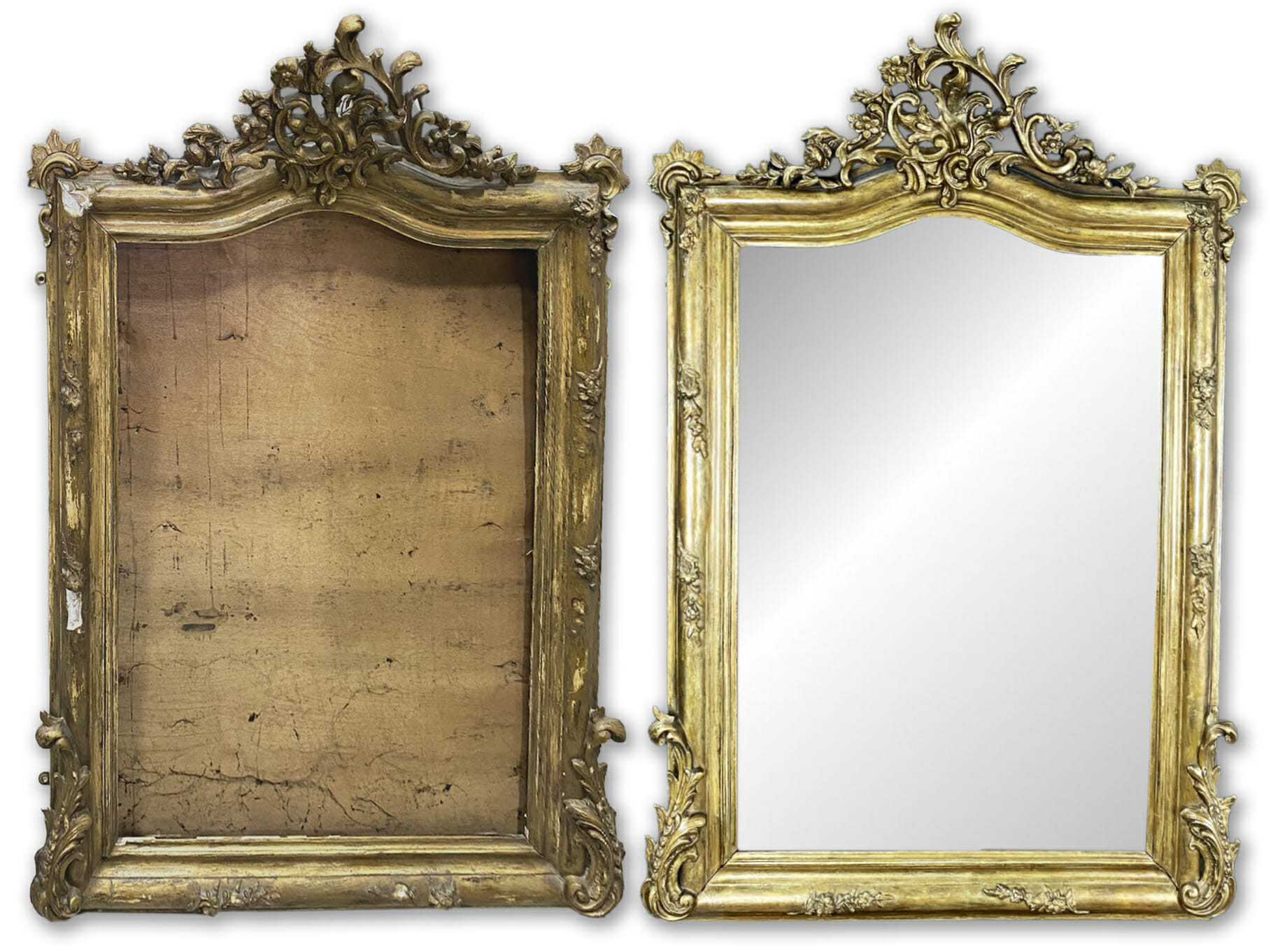
When does a mirror require frame restoration?
If the gilded frame surrounding your mirror has surface dirt, abrasions, flaking, broken pieces or insect holes, our conservators can treat these safely, returning your frame to its prime condition. Trying to fix these at home can lead to unforeseen problems and further damage, so it is recommended that a member of our team with appropriate historical knowledge and training is trusted to restore areas of deterioration safely.
 Above: new pieces can be applied to missing areas as seen with the top detail here, this is then colour-matched with age-appropriate gilding
Above: new pieces can be applied to missing areas as seen with the top detail here, this is then colour-matched with age-appropriate gilding
Our conservators test and tailor appropriate solutions to find the best cleaning option for each individual frame. Before this is completed, they can also consolidate flaking areas of gilding, reattach loose or broken decoration, and even replicate missing sections to ensure no further original pieces are lost.
Abrasions can be re-gilded to bring back the original lustre of the frame. In some cases, the entire frame can be re-gilded to an appropriate finish. This means that new gilding can be matched to either your personal taste or the historic appearance of the object. New gilding can be perfectly aged to ensure it is not a new and overbearing feature on your antique mirror.
Above: our frame conservator applying gold leaf to a frame, piece by piece, this is then aged to suit the antique appearance of the mirror
It is important to restore broken areas, as any wood that is left open to the elements will be more likely to degrade in the future. If broken areas are missing or cannot be re-adhered, new moulds can be taken and perfect replicas can be put in place, these are colour-matched to the rest of the frame.
 Above: if a frame has historically important labels, these will also be preserved during the restoration process
Above: if a frame has historically important labels, these will also be preserved during the restoration process
Joins in the wooden frame can be stabilised and strengthened to ensure the mirror does not become loose, any hanging apparatus on the back can also be assessed for strength and replaced if required. This will help to prevent accidental falls from height in the future.
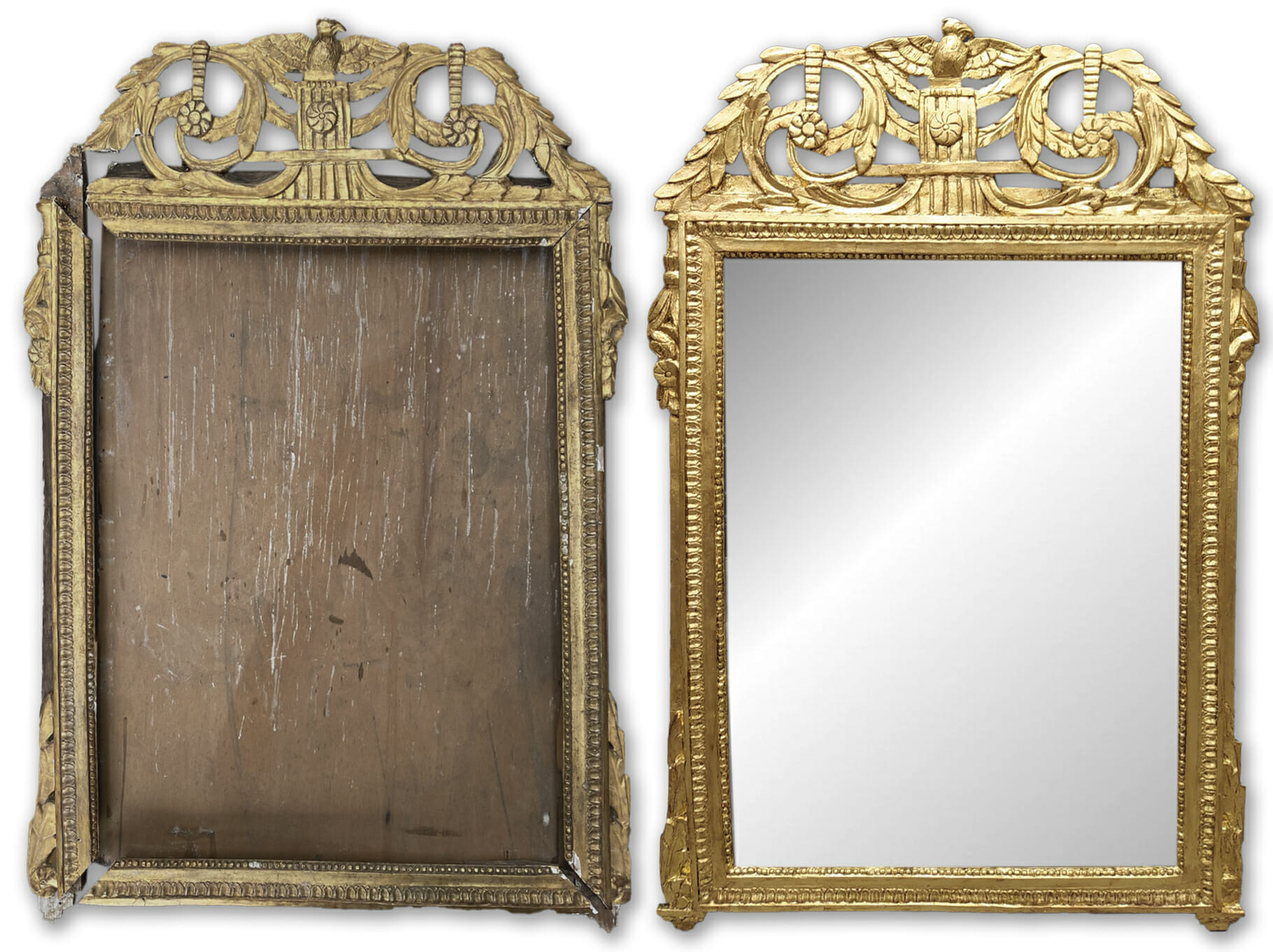
Get in touch
If you have a mirror with a gilt frame that could benefit from a professional assessment or restoration by our conservators and gilding experts, please do not hesitate to reach out to our antique mirror restoration team.
You can get in touch by emailing [email protected] or call 0207 112 7576 for a conversation about our services.

 Above: typical styles of antique mirrors with gold leaf used in different shades on a variety of decorative details
Above: typical styles of antique mirrors with gold leaf used in different shades on a variety of decorative details 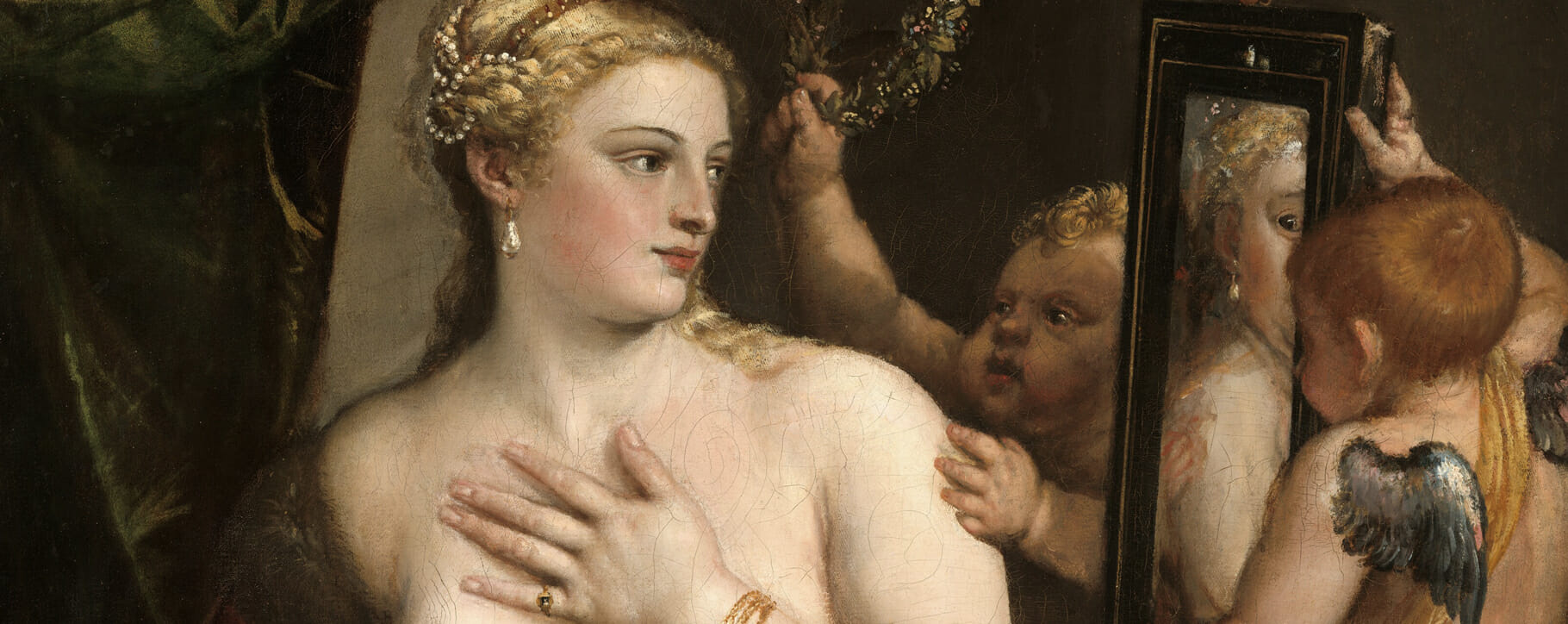 Above: mirrors in art were also popular during the renaissance period, you will often find depictions of Venus looking into a mirror – this detail is from a Paolo Veronese painting dated to 1555
Above: mirrors in art were also popular during the renaissance period, you will often find depictions of Venus looking into a mirror – this detail is from a Paolo Veronese painting dated to 1555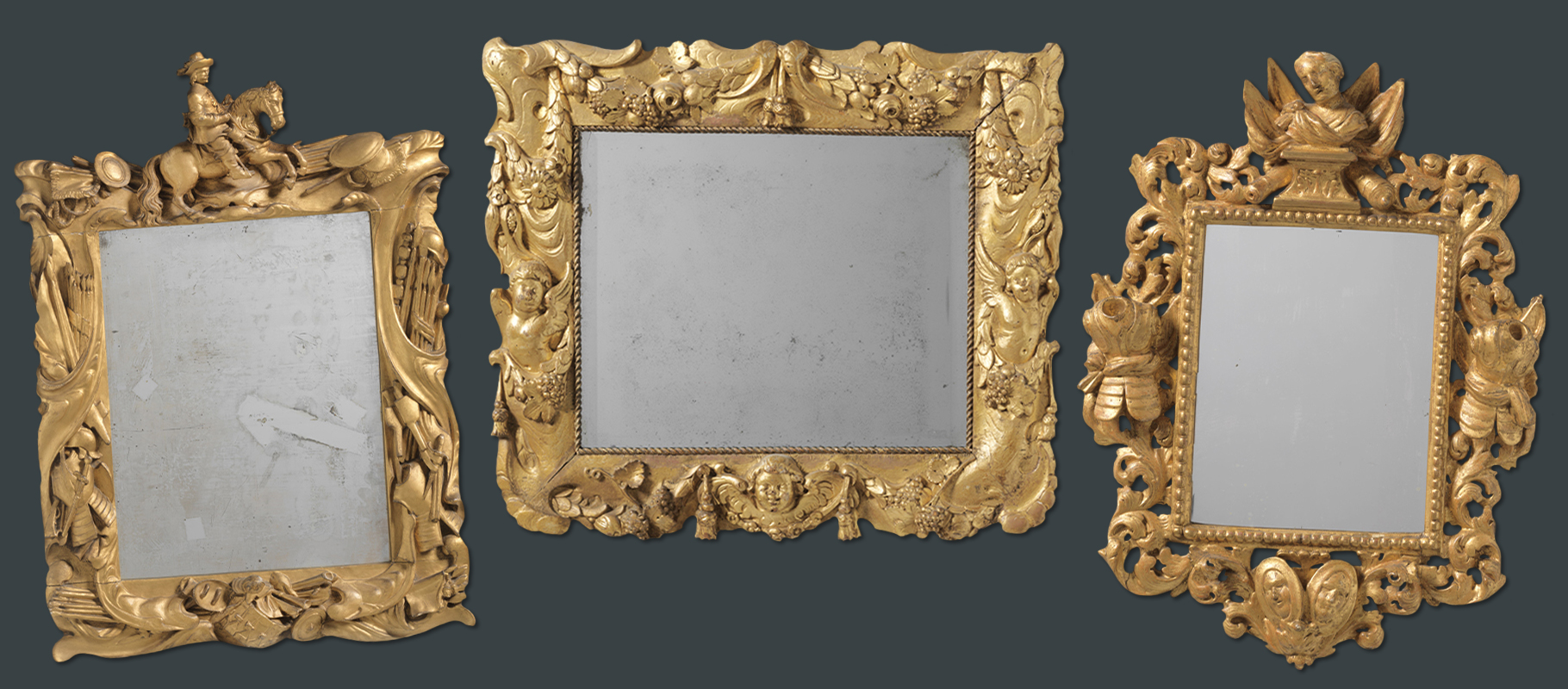 Above: 17th century and early 18th century mirrors with gilt decorative frames made from wood and gesso
Above: 17th century and early 18th century mirrors with gilt decorative frames made from wood and gesso Above: late 17th century and early 18th century mirrors with gold leaf on gesso, enamel with precious stones, venetian glass and inlaid wood
Above: late 17th century and early 18th century mirrors with gold leaf on gesso, enamel with precious stones, venetian glass and inlaid wood Above: examples of 18th century mirror frame styles including baroque, rococo and neoclassical styles
Above: examples of 18th century mirror frame styles including baroque, rococo and neoclassical styles 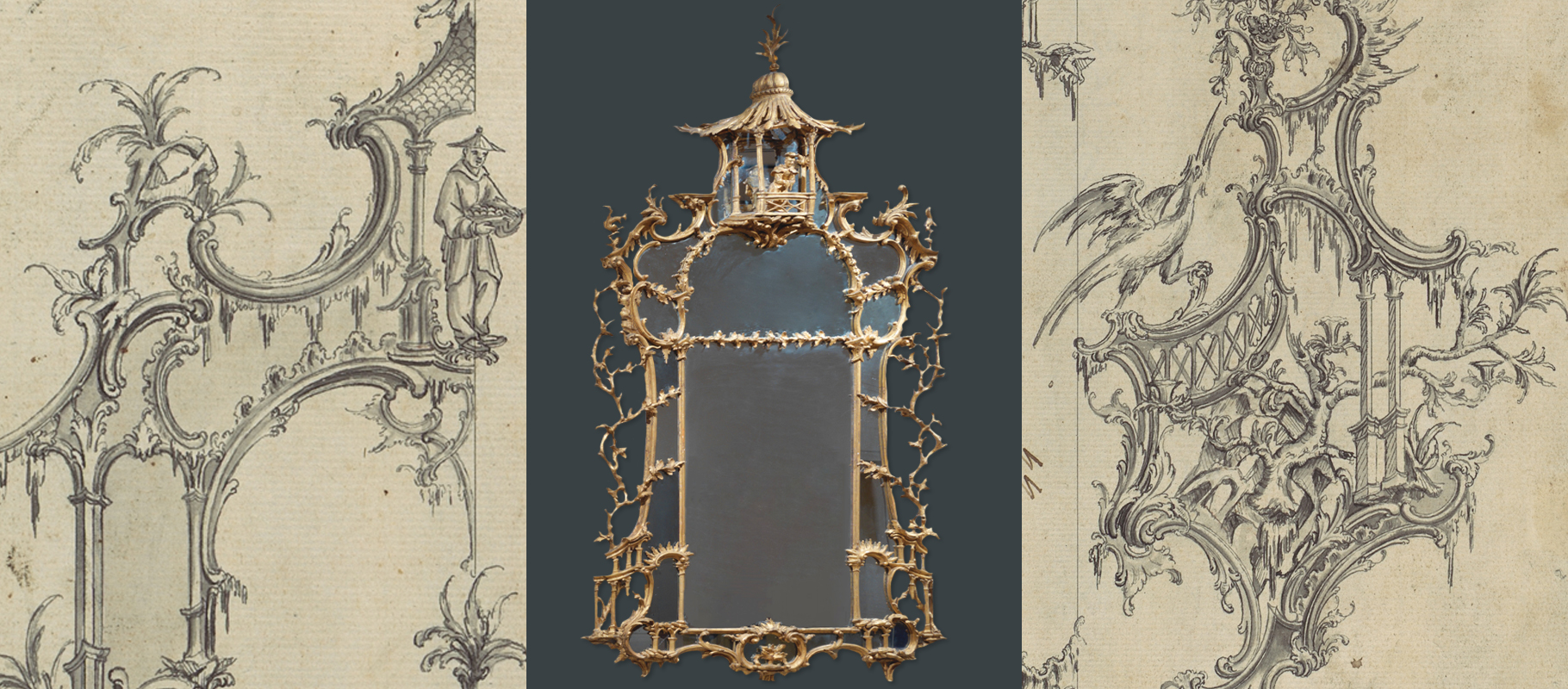 Above: designs by Thomas Chippendale for a
Above: designs by Thomas Chippendale for a 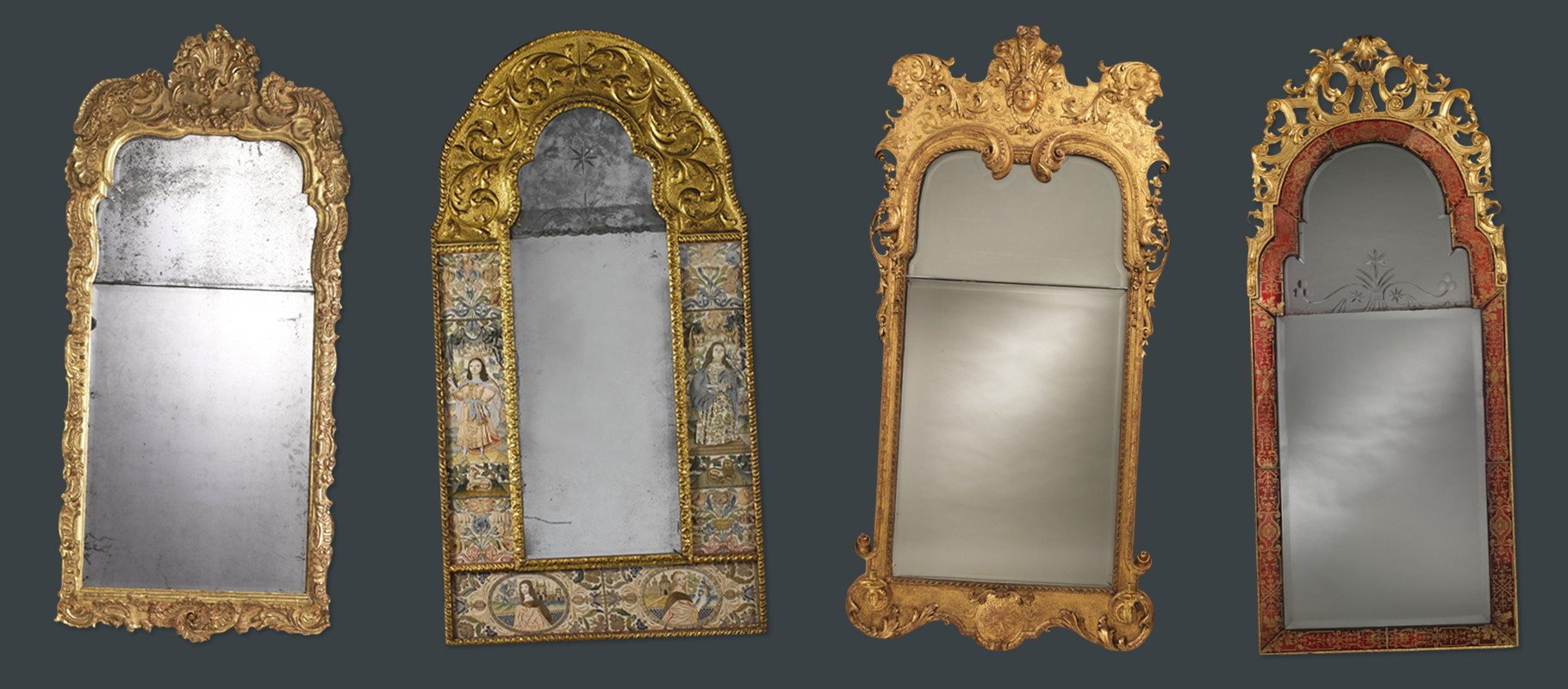 Above: large mirrors had to be constructed from several pieces to achieve their size, you may find that two mirrors have been recycled to form one large piece
Above: large mirrors had to be constructed from several pieces to achieve their size, you may find that two mirrors have been recycled to form one large piece  Above: details from a German rococo mirror from 1755-60 attributed to Johann Michael Hoppenhaupt
Above: details from a German rococo mirror from 1755-60 attributed to Johann Michael Hoppenhaupt 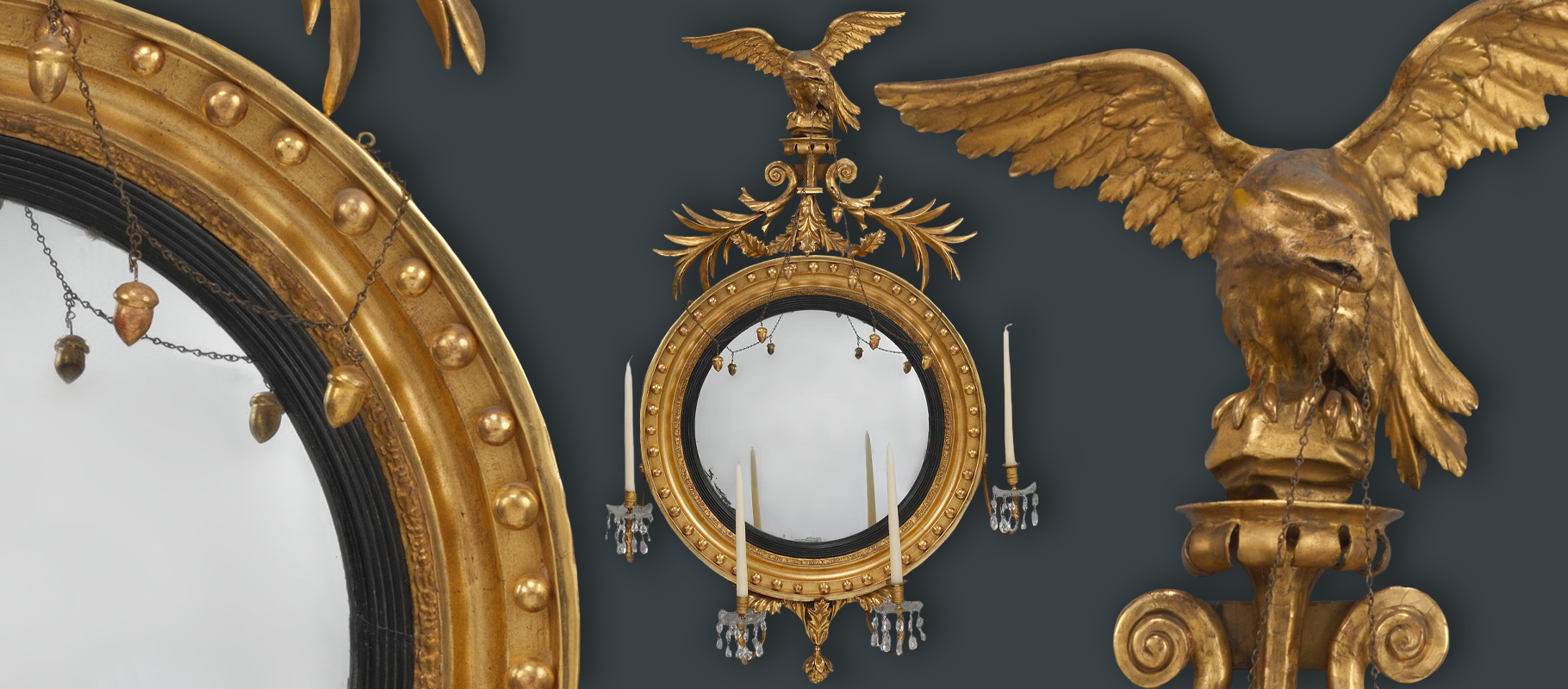 Above: an example of a girandole mirror that allowed candlelight to travel further, this is an American design dated 1817
Above: an example of a girandole mirror that allowed candlelight to travel further, this is an American design dated 1817 Above: the interior of a 19th century French salon featuring several gilded mirrors
Above: the interior of a 19th century French salon featuring several gilded mirrors  Above: fireplace smoke and other atmospheric contaminants can discolour and deteriorate gilding over time, here is an example halfway through a sensitive surface clean by our conservators
Above: fireplace smoke and other atmospheric contaminants can discolour and deteriorate gilding over time, here is an example halfway through a sensitive surface clean by our conservators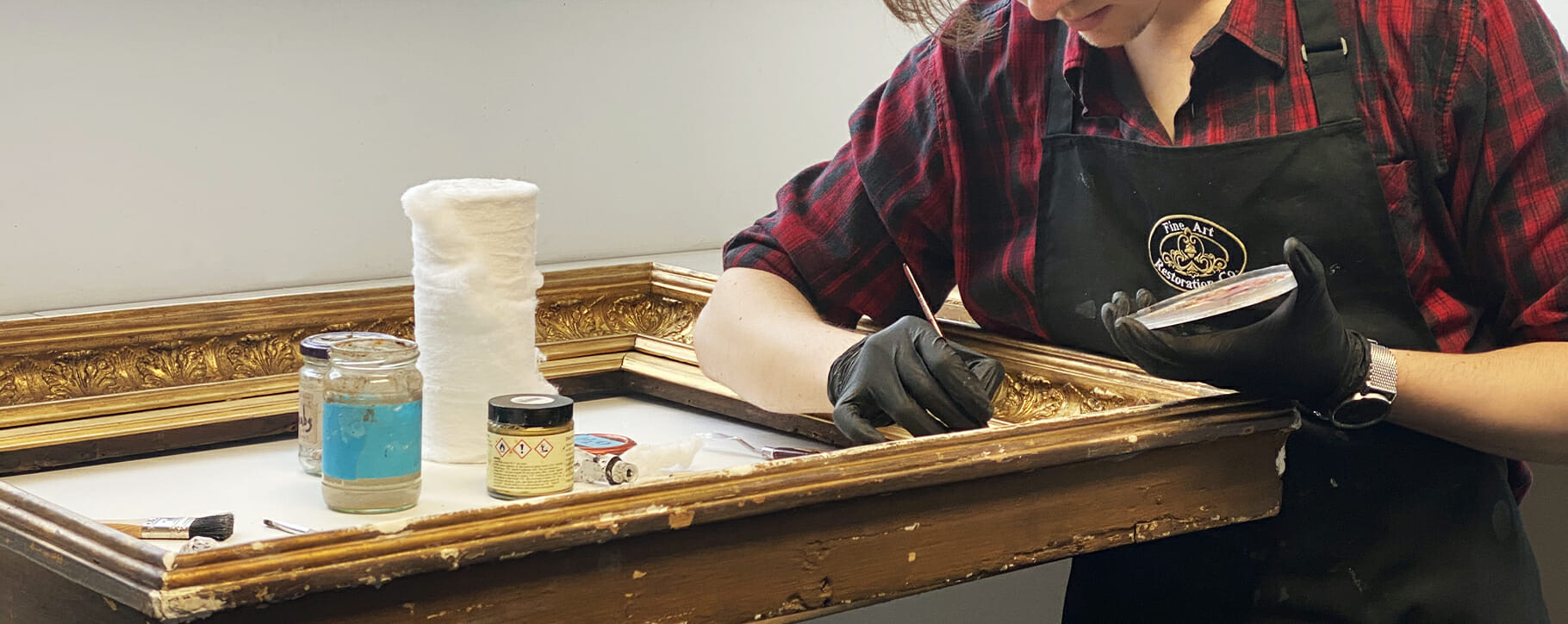 Above: our specialist conservator restoring a frame with careful colour-matching
Above: our specialist conservator restoring a frame with careful colour-matching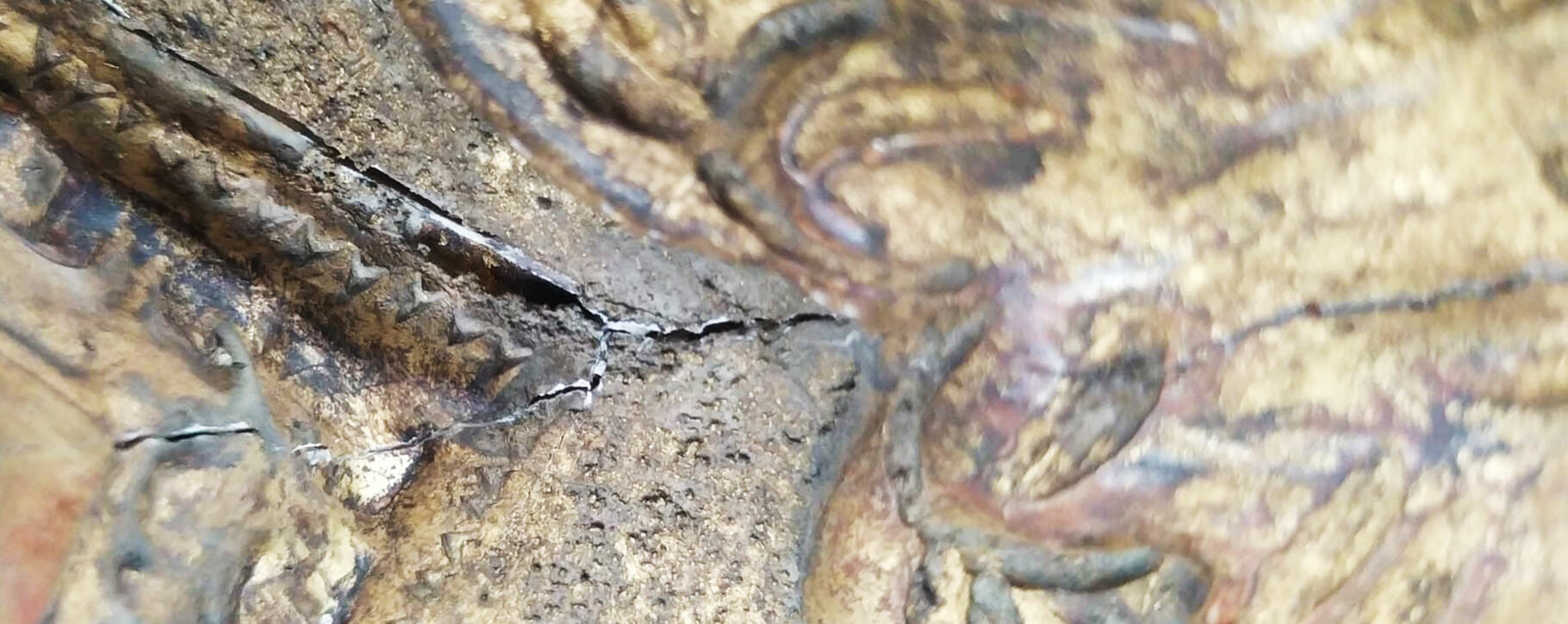 Above: frequent changes in the environment may cause the wood to expand and contract, resulting in cracked gesso and gold leaf
Above: frequent changes in the environment may cause the wood to expand and contract, resulting in cracked gesso and gold leaf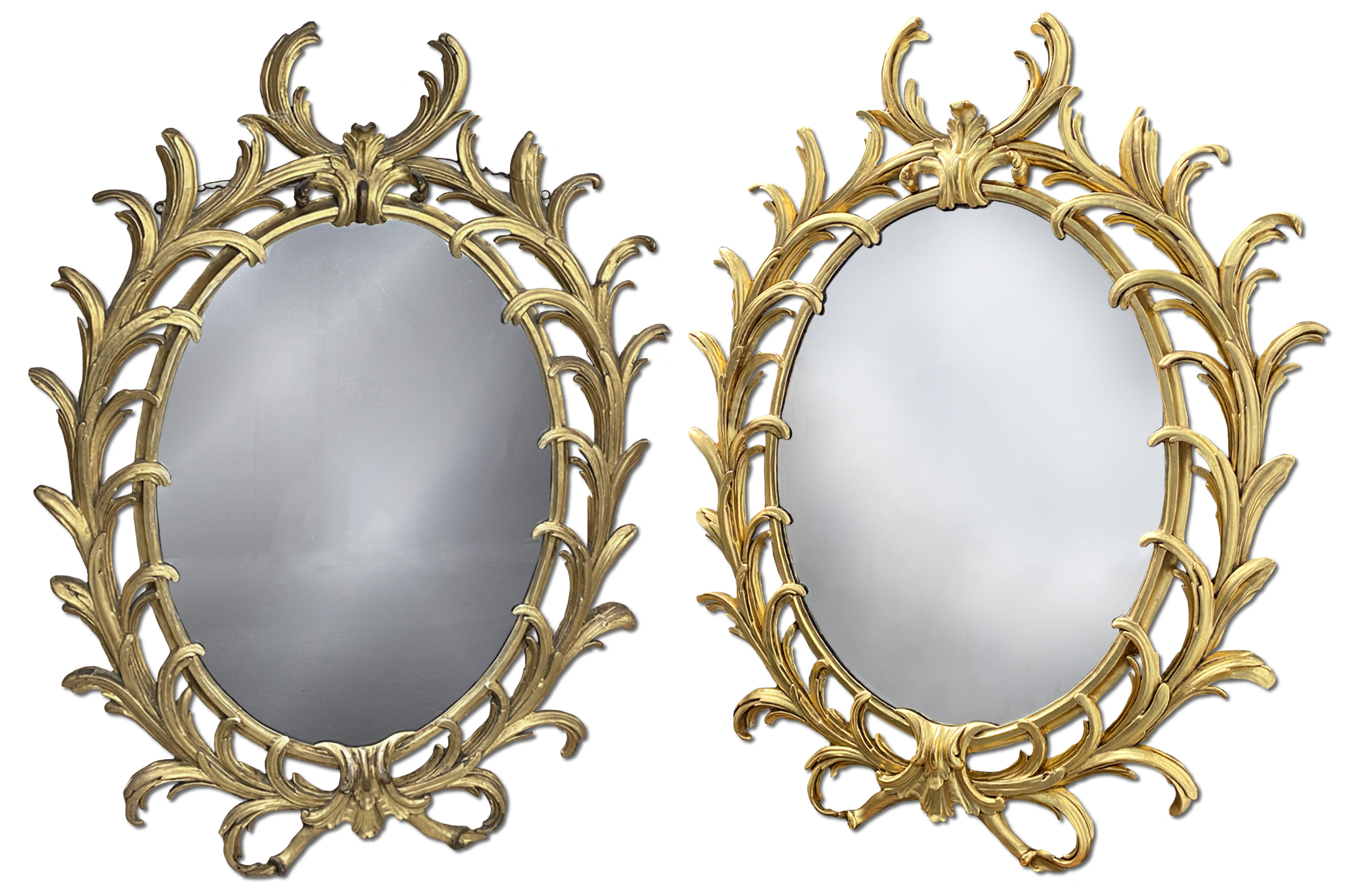
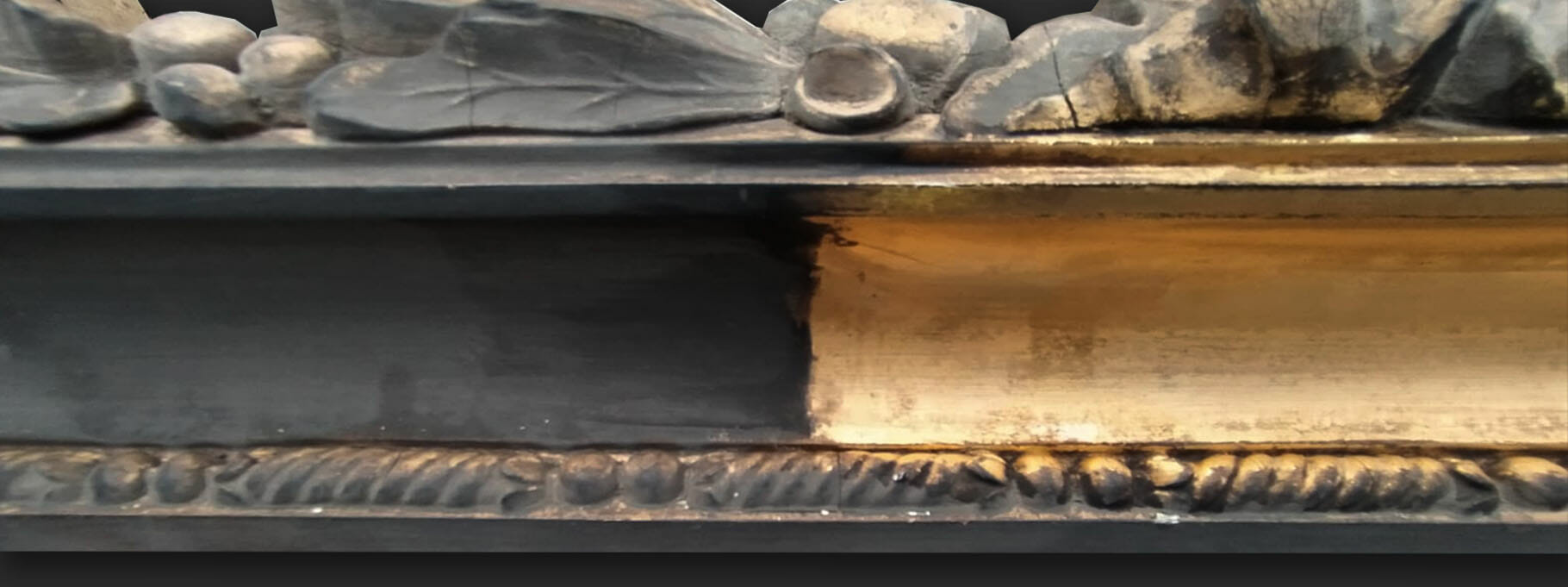 Above: severe contamination from smoke should always be cleaned away by a professional conservator, above is part way through antique mirror frame restoration in our studio
Above: severe contamination from smoke should always be cleaned away by a professional conservator, above is part way through antique mirror frame restoration in our studio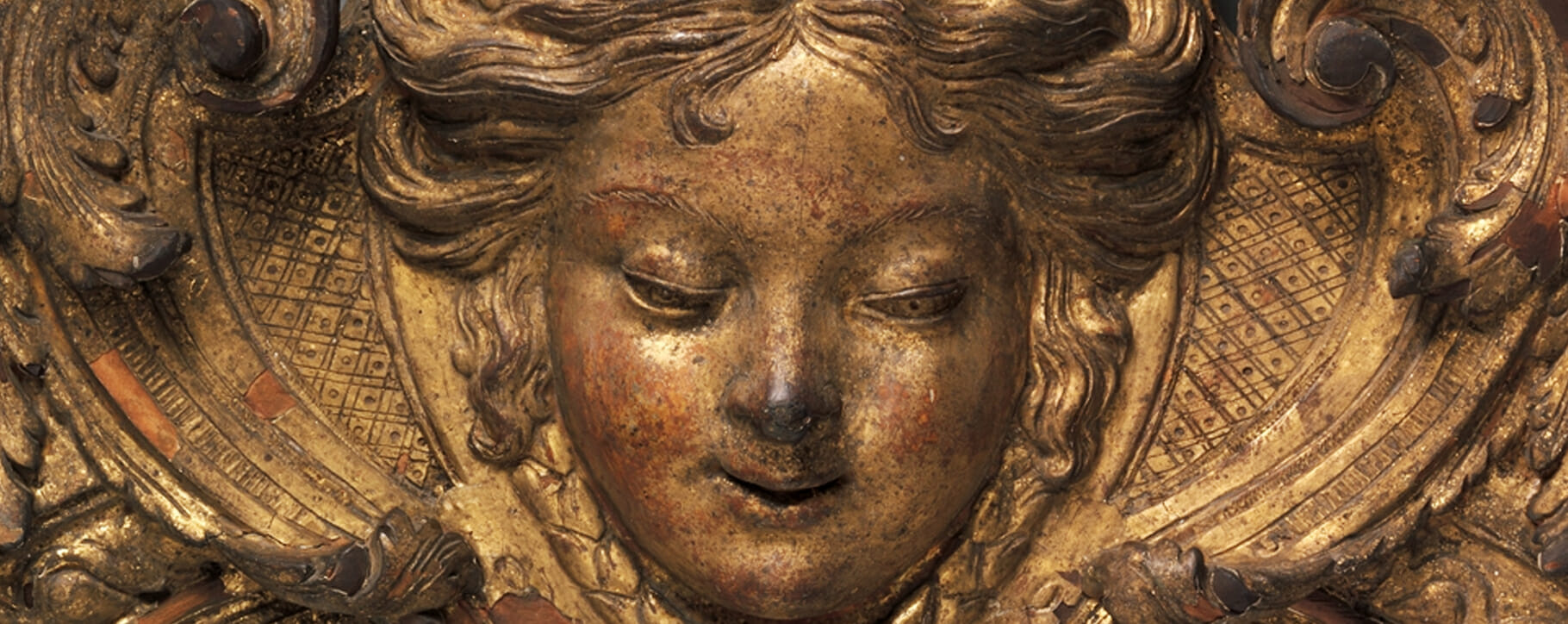 Above: gilding can deteriorate over time and become lost if it is cleaned with rough handling and improper cleaning methods
Above: gilding can deteriorate over time and become lost if it is cleaned with rough handling and improper cleaning methods Above: new pieces can be applied to missing areas as seen with the top detail here, this is then colour-matched with age-appropriate gilding
Above: new pieces can be applied to missing areas as seen with the top detail here, this is then colour-matched with age-appropriate gilding 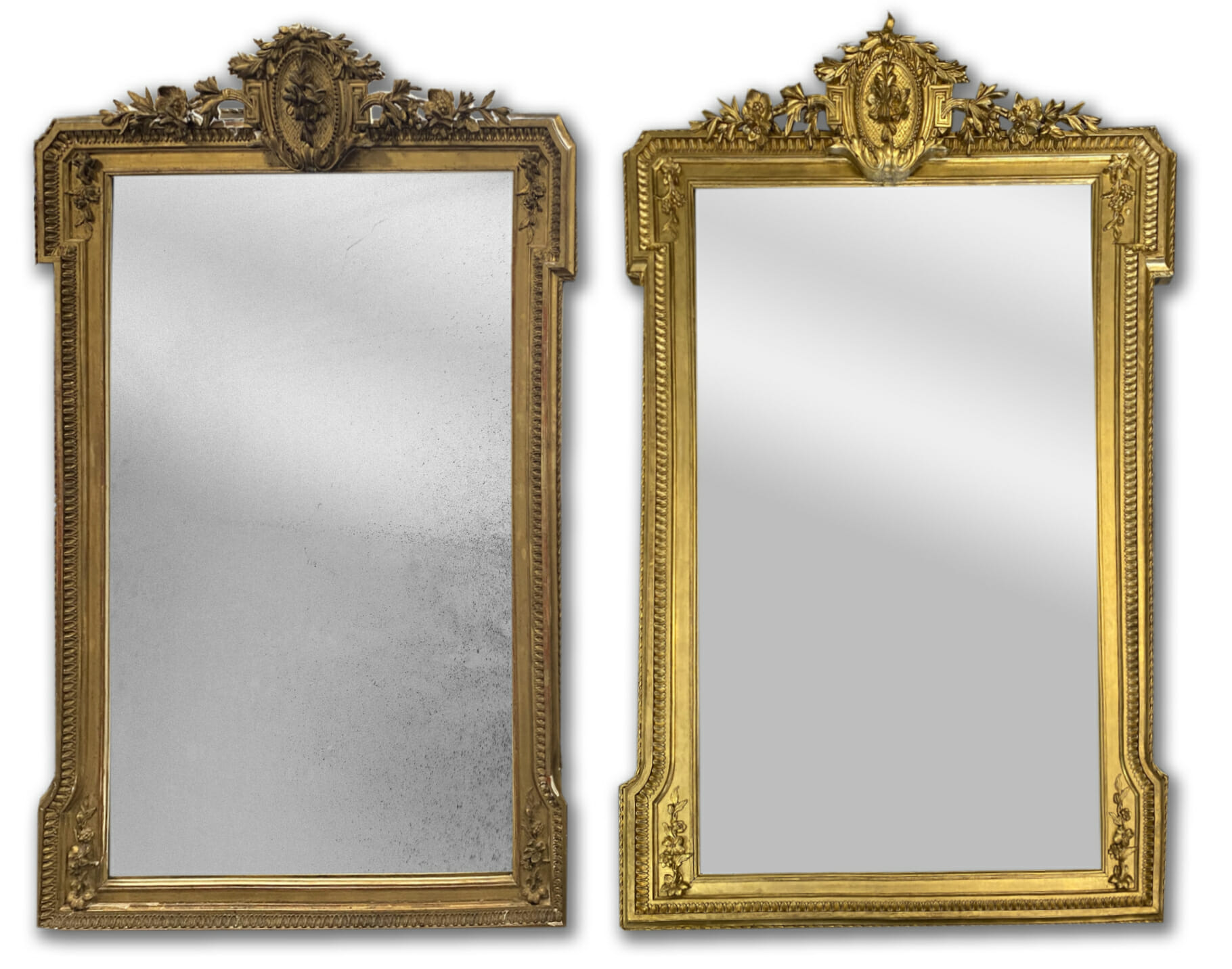
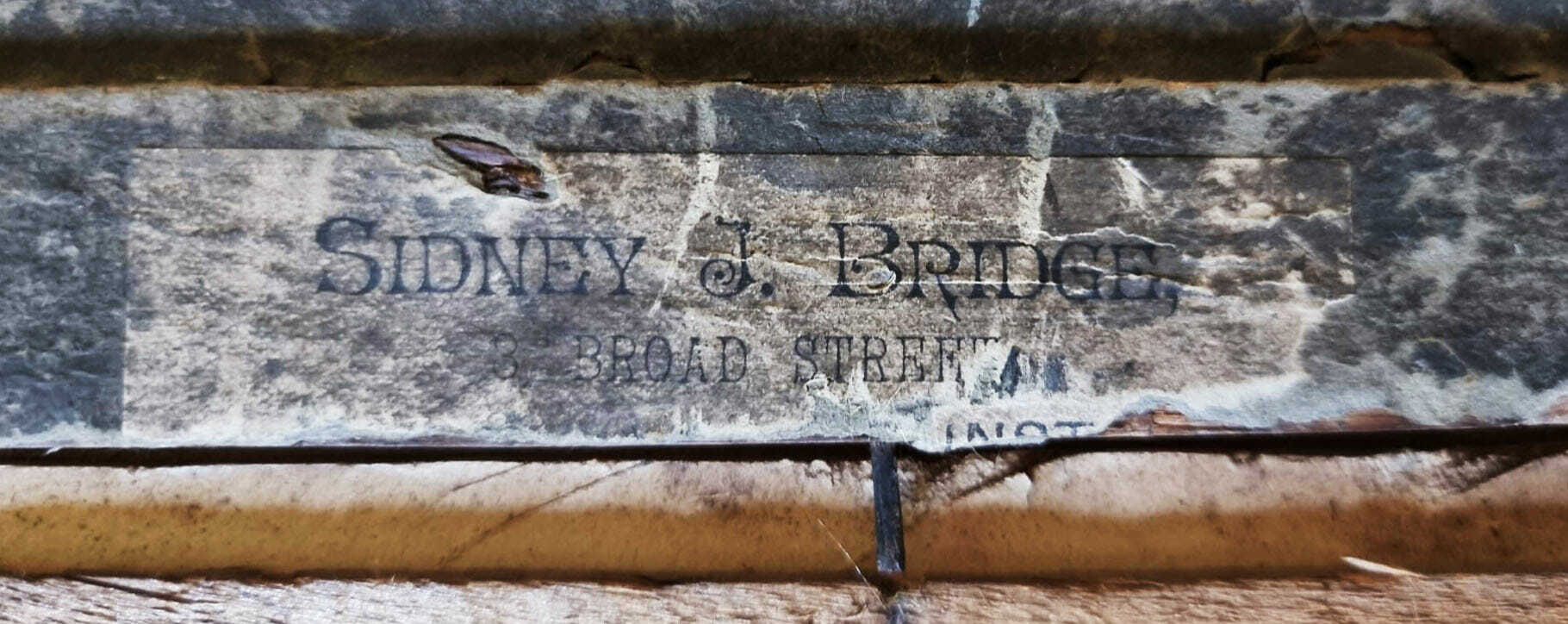 Above: if a frame has historically important labels, these will also be preserved during the restoration process
Above: if a frame has historically important labels, these will also be preserved during the restoration process




